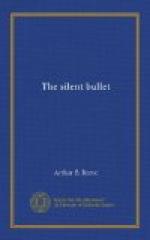As Kennedy and I rode up in the elevator I could not help thinking what an ideal place a down-town office building is for committing a crime, even at this early hour of the evening. If the streets were deserted, the office-buildings were positively uncanny in their grim, black silence with only here and there a light.
The elevator in the first shaft shot down again to the ground floor, and as it disappeared Kennedy took two spools of wire from his pocket and hastily shoved them through the lattice work the third elevator shaft. They quickly unrolled, and I could hear them strike the top of the empty car below in the basement. That meant that Andrews on the ground floor could reach the wires and attach them to the bell.
Quickly in the darkness Kennedy attached the ends of the wires to the curious little coil I had seen him working on in the laboratory, and we proceeded down the hall to the rooms occupied by Poissan, Kennedy had allowed for the wire to reach from the elevator-shaft up this hall, also, and as he walked he paid it out in such a manner that it fell on the floor close to the wall, where, in the darkness, it would never be noticed or stumbled over.
Around an “L” in the hall I could see a ground-glass window with a light shining through it. Kennedy stopped at the window and quickly placed the little coil on the ledge, close up against the glass, with the wires running from it down the hall. Then we entered.
“On time to the minute, Professor,” exclaimed Poissan, snapping his watch. “And this, I presume, is the banker who is interested in my great discovery of making artificial diamonds of any size or colour?” he added, indicating me.
“Yes,” answered Craig, “as I told you, a son of Mr. T. Pierpont Spencer.”
I shook hands with as much dignity as I could assume, for the role of impersonation was a new one to me.
Kennedy carelessly laid his coat and hat on the inside ledge of the ground-glass window, just opposite the spot where he had placed the little coil on the other side of the glass. I noted that the window was simply a large pane of wire-glass set in the wall for the purpose of admitting light in the daytime from the hall outside.
The whole thing seemed eerie to me—especially as Poissan’s assistant was a huge fellow and had an evil look such as I had seen in pictures of the inhabitants of quarters of Paris which one does not frequent except in the company of a safe guide. I was glad Kennedy had brought his revolver, and rather vexed that he had not told me to do likewise. However, I trusted that Craig knew what he was about.
We seated ourselves some distance from a table on which was a huge, plain, oblong contrivance that reminded me of the diagram of a parallelopiped which had caused so much trouble in my solid geometry at college.
“That’s the electric furnace, sir,” said Craig to me with an assumed deference, becoming a college professor explaining things to the son of a great financier. “You see the electrodes at either end? When the current is turned on and led through them into the furnace you can get the most amazing temperatures in the crucible. The most refractory of chemical compounds can be broken up by that heat. What is the highest temperature you have attained, Professor?”




